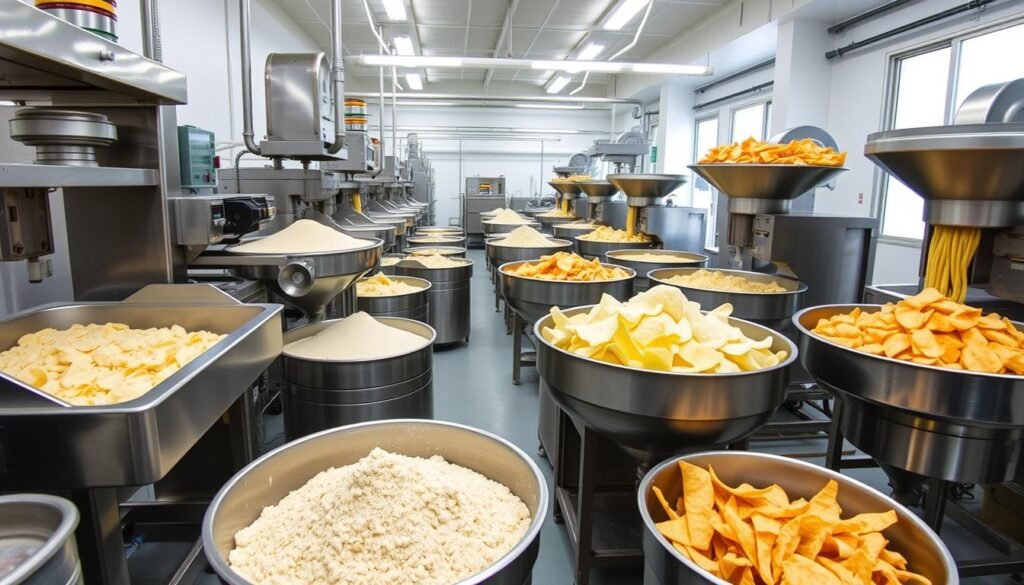G’day, mates! We’re starting an exciting journey into taro processing. This root veggie has been a key part of many cultures for ages. Now, we’re seeing big improvements in how we process it.
As we explore taro, we’re curious: what makes it so special? How can we use new taro processing methods to bring out its best? With the world producing over 494 million tons of root veggies in 2017, demand is high. Africa, Asia, Europe, and America are all major players in this growth.
Key Takeaways
- Taro is a tropical root crop with a rich history, belonging to the Araceae family and encompassing over 10,000 landraces.
- Advances in taro processing technology are unlocking the potential of this versatile root vegetable.
- Root vegetable processing, including taro processing, is on the rise globally.
- Innovative techniques like physical modification and grinding are improving the quality and versatility of taro products.
- The global demand for root vegetables is driving innovation in the industry, with opportunities for growth and development in taro processing and root vegetable processing.
- Taro processing and root vegetable processing are critical components of the food industry, with a significant impact on global food security and sustainability.
The Rich Heritage of Taro: From Ancient Staple to Modern Superfood
Taro is one of the oldest crops, with roots in the Solomon Islands nearly 28,000 years ago. It has been crucial in many cultures, changing from a staple to a modern superfood.
Traditional Uses Across Pacific Cultures
In Pacific cultures, taro is a key part of daily life and ceremonies. It’s turned into various taro products, like:
- Poi in Hawaii
- Oro in Fiji
- Luau in Samoa
These dishes not only feed people but also connect them to their heritage.
Nutritional Profile and Health Benefits
Taro is full of important nutrients, making it a key part of taro cuisine. It has:
- High fiber for digestion
- Vitamins A and C for immune health
- Minerals like potassium and magnesium
Modern Revival in Global Cuisine
Today, taro is making a comeback in kitchens around the world. Chefs are using taro in new dishes, from taro lattes to desserts. This is thanks to sustainable taro farming practices, keeping taro available for the future.
| Nutrient | Amount per 100g |
|---|---|
| Calories | 142 kcal |
| Fiber | 5.1 g |
| Vitamin C | 18 mg |
| Potassium | 591 mg |
| Magnesium | 40 mg |
Understanding Different Taro Varieties for Processing
Taro farming offers a wide range of cultivars, each with its own benefits. With over 200 selected varieties, farmers can pick the best for their needs.
The main taro types are eddoe and dasheen. Eddoe taro is great for making taro chips and flour because of its small, round corms. Dasheen taro, with its larger corms, is often used in poi and other traditional dishes.
- Eddoe: Best for dry processing methods like drying and milling.
- Dasheen: Preferred for wet processing and fresh consumption.
Good taro cultivation practices are key to getting high yields and quality. Farmers need to think about soil type, water, and climate when picking taro varieties. Using the right farming techniques helps each variety grow well, leading to better processing results.
| Variety | Primary Use | Optimal Farming Conditions |
|---|---|---|
| Eddoe | Taro chips, flour | Dry paddies, well-drained soils |
| Dasheen | Poi, fresh consumption | Wet paddies, high moisture areas |
Knowing about the different taro varieties helps us improve our farming and processing. This knowledge increases productivity and meets the market’s varied needs.
Essential Taro Processing Equipment and Methods
Processing taro needs the right tools and techniques. We use advanced equipment for high-quality root vegetable processing. Each step, from washing to storage, is key.
Washing and Peeling Technology
Our washing and peeling starts with the Li An Machinery Root Veg Washing Peeling machine. This top-notch equipment cleans and peels taro roots well, keeping them intact.
Cutting and Slicing Equipment
After washing, we use cutting and slicing machines for speed and consistency. These machines make taro ready for further processing or packaging.
Drying and Storage Solutions
Drying and storing taro right is crucial for quality. We use drying equipment that removes moisture well without harming the texture. Our storage keeps taro fresh until it gets to consumers.
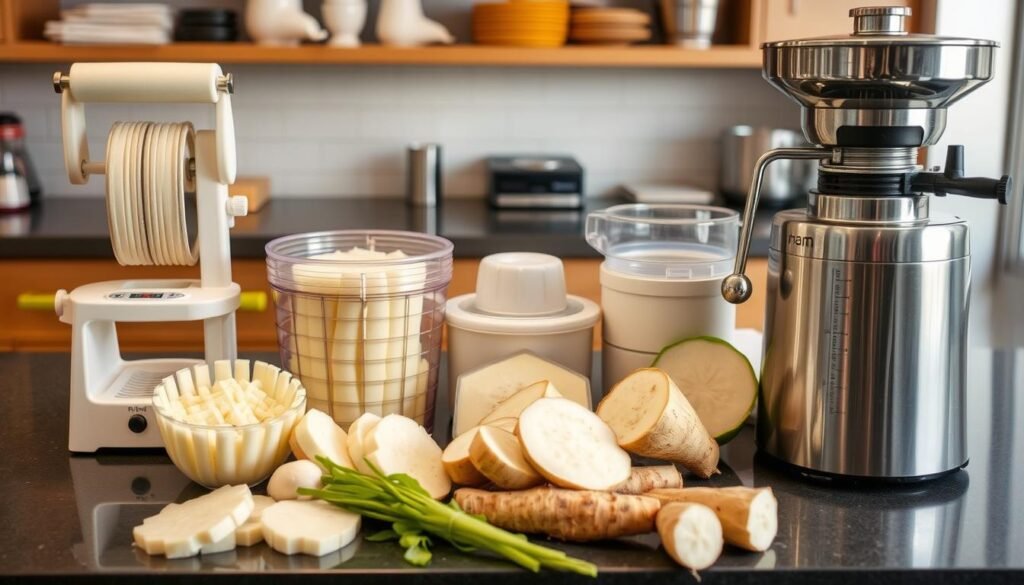
| Equipment Type | Function |
|---|---|
| Li An Root Veg Washing Peeling Machine | Cleans and peels taro roots efficiently |
| Cutting and Slicing Machine | Ensures uniform slicing for consistency |
| Drying Equipment | Removes moisture to preserve quality |
| Storage Facilities | Maintains optimal conditions to extend shelf life |
Commercial Taro Processing: Best Practices and Standards
In the world of taro processing, following best practices is key. This ensures our taro products are of high quality. We focus on food safety by keeping our facilities clean and following strict hygiene rules.
Our team gets regular training on the latest safety rules. This keeps them up to date and ready to handle any challenges.
Quality control is a big part of what we do. We use top-notch machines to keep the size and texture of our taro consistent. This is important for making our customers happy.
We check every step of the taro processing process, from washing to packaging. This helps us catch and fix any problems early on. It makes our products more reliable and of better quality.
Being efficient is important for us. We want to make more products without losing quality. Our streamlined processes help us do this by reducing waste and using resources better.
For example, global taro processing has grown a lot. More areas are producing taro, and more is being exported. This shows that our best practices are working well.
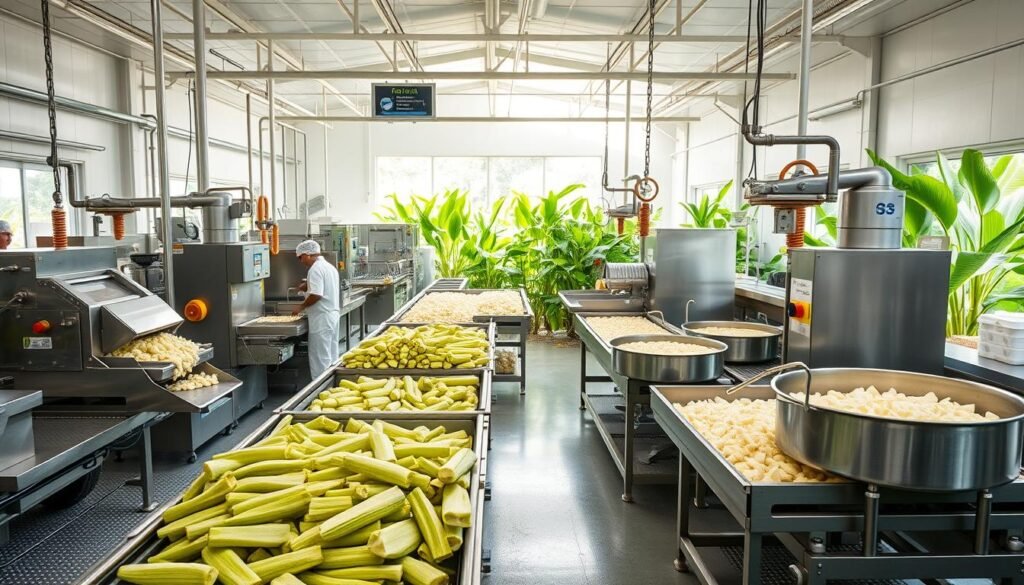
| Best Practice | Description | Impact on Taro Products |
|---|---|---|
| Hygiene Protocols | Implementing strict cleaning and sanitation procedures. | Ensures food safety and prevents contamination. |
| Advanced Machinery | Using state-of-the-art equipment for processing. | Maintains consistency and reduces defects. |
| Quality Control | Regular inspections and testing of products. | Enhances product reliability and customer satisfaction. |
| Efficient Processes | Optimizing workflows to minimize waste. | Maximizes output and reduces costs. |
Innovation in Taro Products Development
We’re excited to explore new taro products. From taro flour to taro chips and taro snacks, we’re making them fit for today’s fast-paced lives.
Taro Flour Production
Our taro flour is changing gluten-free baking. We turn taro tubers into a fine powder. This gives it lots of protein and nutrients, great for those watching their diet.
Taro Chips Manufacturing
Making tasty taro chips is all about new ways to slice and season. Our tests showed that adding extra flavors makes them even more appealing. This opens up a world of flavors for snack lovers.
Frozen Taro Products
Frozen taro snacks are perfect for those who are always on the move. They keep well and are easy to cook, making them ideal for busy lives.

| Treatment | Appearance Rating | Texture | Odor | Taste | Acceptability |
|---|---|---|---|---|---|
| 1 | 2.5 (Slightly Appealing) | Moderately Crunchy | No Odor | Not Delicious | Low |
| 2 | 4.0 (Moderately Appealing) | Moderately Crunchy | Enhancing Odor | Slightly Delicious | Moderate |
| 3 | 4.1 (Moderately Appealing) | Moderately Crunchy | Moderately Discernible | Moderately Delicious | High |
| 4 | 4.3 (Moderately Appealing) | Moderately Crunchy | Moderately Discernible | Moderately Delicious | High |
Quality Control in Taro Processing
We focus on keeping high standards in taro processing. Every step is checked to ensure top quality for our customers.
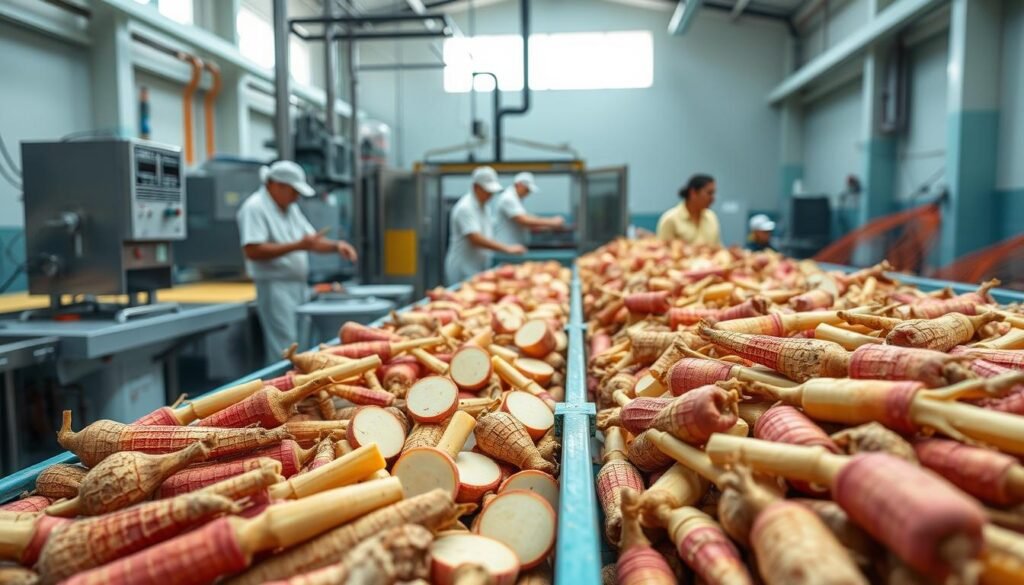
We start by picking the best taro roots. We look at size, weight, and no defects. This makes sure our products are consistent.
- Raw Material Inspection: We check taro roots for freshness and quality.
- Washing and Peeling: We use tech to clean and peel efficiently.
- Cutting and Slicing: We cut taro into uniform sizes for even processing.
- Drying and Storage: We keep the right conditions to keep quality.
- Final Product Testing: We do detailed checks before packaging.
We use automated systems to find any flaws. Our tests check starch and moisture levels. This makes sure each batch is up to standard.
Our quality control steps make our taro products tasty and healthy. We aim for excellence in every product. This makes our products stand out in the market.
| Quality Control Stage | Key Metrics | Technology Used |
|---|---|---|
| Raw Material Selection | Size, Weight, Defect-Free | Automated Sorting Systems |
| Washing and Peeling | Cleanliness, Residue Removal | High-Efficiency Washers |
| Cutting and Slicing | Uniformity, Precision | Precision Cutting Equipment |
| Drying and Storage | Moisture Levels, Temperature Control | Climate-Controlled Dryers |
| Final Product Inspection | Starch Content, Moisture Content | Advanced Testing Methods |
Advanced Processing Techniques for Taro Value Addition
We’re excited to dive into the latest taro processing advancements. These methods not only boost quality but also create new opportunities for taro in the market.
Enzyme Treatment Methods
Our enzyme treatment makes taro products more digestible and textured. It breaks down complex carbs, making taro more enjoyable in different dishes.
Modified Starch Production
Creating resistant starch through taro processing is a breakthrough. It reduces the glycemic index, making taro products better for blood sugar control.
Novel Processing Applications
New taro processing methods are broadening its use in food. They help create texturising agents and functional ingredients, boosting taro’s versatility.
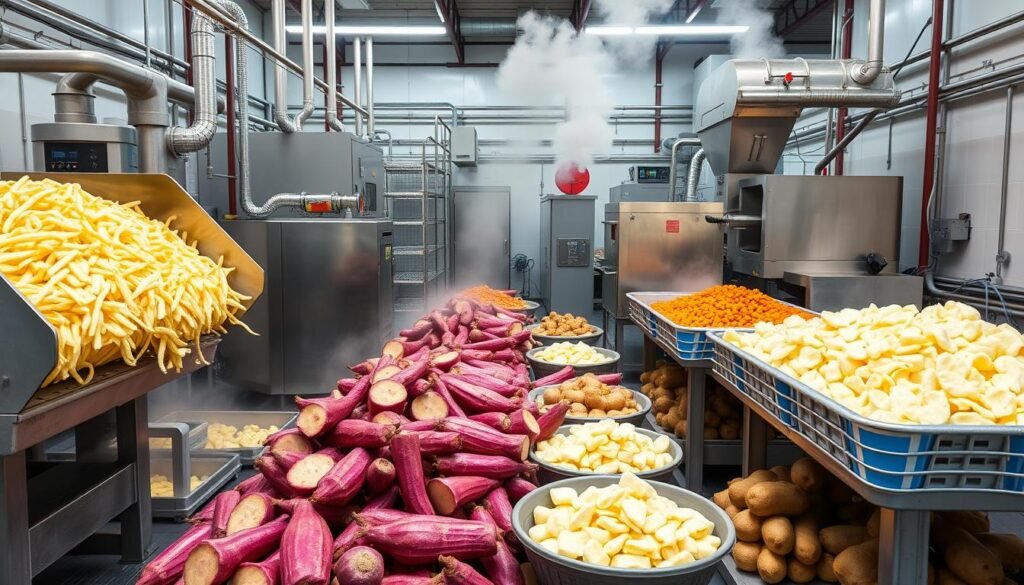
| Processing Technique | Benefit | Application |
|---|---|---|
| Enzyme Treatment | Improves digestibility and texture | Enhanced culinary dishes |
| Modified Starch Production | Lowers glycemic index | Health-conscious food products |
| Novel Processing Applications | Increases versatility | Texturising agents and functional ingredients |
Sustainable Taro Processing Practices
In today’s world, sustainability is key in taro cultivation. We aim to make our taro processing as green as we can.
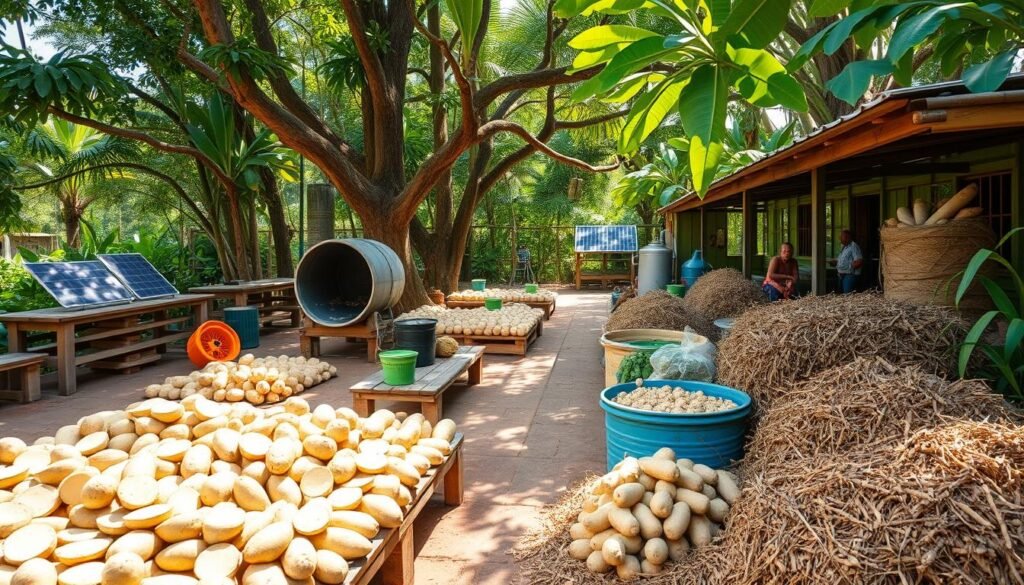
- Energy Efficiency: We use renewable energy to power our places, cutting down on carbon emissions.
- Water Conservation: Our taro farming uses smart irrigation systems to save water.
- Waste Reduction: We recycle and compost to reduce our environmental impact.
- Sustainable Farming Practices: We use crop rotation and organic farming to keep our taro healthy for the long term.
These steps not only protect the environment but also improve the quality and consistency of our taro.
Here’s a table showing global taro production. It shows our dedication to sustainable taro farming:
| Region | Production (tons) | Percentage of Global Production |
|---|---|---|
| West Africa (Nigeria, Cameroon, Ghana) | 10.6 million | 83.6% |
| USA, Canada, Japan, Turkey, Central & South America | 2 million | 16.4% |
By using these sustainable practices in our taro farming and processing, we ensure a responsible and profitable operation for the future.
Market Opportunities for Processed Taro Products
The global taro market is growing fast. It was worth USD 5.2 million in 2023 and is expected to hit USD 10.5 million by 2032. This shows a steady increase in demand.
Global Market Analysis
Asia-Pacific is the biggest producer of taro, making up over 75% of global production. The Philippines, China, and Indonesia are the top taro producers. Companies like BobaBam and Golden Ocean Corp. are key players, ensuring a wide range of taro products are available.
Consumer Trends and Preferences
People are looking for healthier food options, which is good for taro snacks like chips and crackers. Taro recipes are also becoming more popular in modern cooking. This is attracting food lovers who want to try new tastes.
Export Potential
The United States is the biggest buyer of taro, making up 35.7% of taro imports in 2021. Other areas like North America and Europe are also showing interest. This opens up big opportunities for exporting high-quality taro products.
Optimising Your Taro Processing Operation with Li An Machinery
Boosting your taro processing starts with the right gear. We suggest the Li An Machinery Root Veg Washing Peeling machine for top-notch root vegetable processing.
This cutting-edge machine makes washing and peeling faster and easier. It cuts down on time and effort needed. Its smart system also keeps quality high, cutting down on waste and boosting output.
- Efficiency: Processes big amounts quickly.
- Consistency: Keeps quality the same in every batch.
- Ease of Integration: Fits well into your current setup.
- Low Maintenance: Built to last with little upkeep needed.
Adding the Li An Root Veg Washing Peeling machine can greatly improve your taro processing efficiency and quality. It’s perfect for growing your operation or fine-tuning your current setup.
| Feature | Benefit |
|---|---|
| High Throughput | Increase production capacity without extra labour |
| Automated Washing | Guarantees deep cleaning with less manual work |
| Precision Peeling | Gets uniform peeling, improving product quality |
| Energy Efficient | Lessens costs and environmental impact |
Conclusion: Embracing the Future of Taro Processing
Taro processing is set to grow in the food world. More people want healthy, natural foods, boosting demand for taro products.
Taro is great for many dishes, from chips to flours. It’s full of fiber, vitamins, and minerals, making it a hit with health fans.
More people are trying different foods, which means more chances for taro. This trend is creating new markets for taro products.
New tech in taro processing lets us make more kinds of products. This meets changing tastes and keeps businesses ahead.
By using eco-friendly methods and making new products, taro can help us eat better. Let’s work together to make taro a staple in kitchens everywhere.
FAQ
What are the different varieties of taro available for processing?
We work with several taro varieties, including eddoe and dasheen. Each type has unique characteristics. They are suitable for different taro products like taro chips and taro flour. Choosing the right variety depends on your specific processing needs and the final product you aim to create.
How can taro be used in gluten-free baking?
Taro flour is a fantastic gluten-free alternative. We use it in a variety of baking recipes. It adds a subtle sweetness and a unique texture to breads, pastries, and other baked goods. This makes it a popular choice for health-conscious consumers looking for taro recipes that cater to dietary restrictions.
What are the best practices for sustainable taro farming?
Sustainable taro farming involves water conservation techniques, crop rotation, and the use of eco-friendly fertilizers. By implementing these practices, we ensure a steady supply of high-quality taro while minimizing our environmental impact. Sustainable methods also support taro cultivation that preserves soil health and biodiversity.
What innovative taro snacks are currently popular in the market?
Taro snacks like crispy taro chips and baked taro crisps are gaining traction among consumers. These snacks are not only delicious but also offer healthier alternatives to traditional potato chips. We continuously innovate our taro product lineup to include new flavors and textures that appeal to adventurous snackers.
How does modern technology enhance taro processing?
Modern technology, such as the Li An machinery Root Veg Washing Peeling machine, streamlines the taro processing workflow. It automates tasks like washing, peeling, cutting, and slicing. This ensures consistency, improves efficiency, and reduces labor costs. It allows us to produce high-quality root vegetable processed products at scale.
What are some popular global cuisines that incorporate taro?
Taro is a versatile ingredient featured in various cuisines worldwide. From traditional poi in Hawaiian dishes to contemporary taro cuisine in trendy cafes, it is used in everything from savory stews to sweet desserts. Its adaptability makes it a favorite in taro recipes across different cultures.
What are the health benefits of including taro in your diet?
Taro is chockers with good stuff, offering essential nutrients like fiber, vitamins, and minerals. It supports digestive health, provides sustained energy, and is rich in antioxidants. Incorporating taro into your diet through products like taro flour and taro snacks can contribute to overall well-being.
How do you ensure quality control in taro processing?
Quality control is paramount in our taro processing operations. We implement various checkpoints, from selecting the best raw materials to final product inspection. Utilizing advanced quality control technology like automated sorting systems and thorough testing methods ensures that every taro product meets our high standards.
What market opportunities exist for exporting processed taro products?
The global market for processed taro products is expanding, with significant demand in regions like the United States. Health-conscious consumers and the rising popularity of gluten-free and exotic snacks create ample opportunities for exporting products like taro chips and taro flour. Understanding consumer trends and preferences helps us tailor our offerings to meet international demands.
Can you share some innovative taro recipes for home cooks?
Absolutely! Here are a few taro recipes you can try at home:
- Taro Chips: A healthy alternative to potato chips, perfect for snacking.
- Taro Bread: Soft and slightly sweet, ideal for sandwiches.
- Taro Ice Cream: A unique dessert with a creamy texture and subtle flavor.
Experimenting with these recipes can help you incorporate more taro cuisine into your meals.
Source Links
- CRISPR/Cas9: an advanced platform for root and tuber crops improvement – https://pmc.ncbi.nlm.nih.gov/articles/PMC10836405/
- Recent Advances in Physical Processing Techniques to Enhance the Resistant Starch Content in Foods: A Review – https://www.mdpi.com/2304-8158/13/17/2770
- PDF – https://repository.ju.edu.et/bitstream/handle/123456789/5706/Misgana Banti MSc Thesis.pdf?sequence=1&isAllowed=y
- Classification of African Native Plant Foods Based on Their Processing Levels – https://pmc.ncbi.nlm.nih.gov/articles/PMC9102804/
- Biodiversity in agricultural and food systems of jhum landscape in the West Garo Hills, North-eastern India – https://pmc.ncbi.nlm.nih.gov/articles/PMC8761519/
- A Review of Indigenous Food Crops in Africa and the Implications for more Sustainable and Healthy Food Systems – https://www.mdpi.com/2071-1050/12/8/3493
- TARO – https://plants.usda.gov/DocumentLibrary/plantguide/pdf/cs_coes.pdf
- Taro Roots: An Underexploited Root Crop – https://pmc.ncbi.nlm.nih.gov/articles/PMC10421445/
- PDF – https://www.ctahr.hawaii.edu/oc/freepubs/pdf/Taro_Industry_Analysis4.pdf
- Taro – https://en.wikipedia.org/wiki/Taro
- PDF – https://www.fao.org/fileadmin/user_upload/inpho/docs/Post_Harvest_Compendium_-_Edible_aroids.pdf
- Effects of Taro Varieties and Blending Ratios on Proximate Compositions and Anti-Nutritional Factors of Taro (Colocasia esculenta) –Wheat (Aestium triticium) Composite Bread – https://juniperpublishers.com/ctbeb/CTBEB.MS.ID.555935.php
- PDF – https://ijisrt.com/assets/upload/files/IJISRT22OCT071_(1).pdf
- Development of Innovative Taro-Based Product Management with Zero-Waste Concept to Increase the Independence of PKK Wanagiri – https://www.academia.edu/99797846/Development_of_Innovative_Taro_Based_Product_Management_with_Zero_Waste_Concept_to_Increase_the_Independence_of_PKK_Wanagiri
- PDF – https://www.iiste.org/Journals/index.php/FSQM/article/viewFile/19775/20137
- Anticancer and Immunomodulatory Benefits of Taro (Colocasia esculenta) Corms, an Underexploited Tuber Crop – https://www.mdpi.com/1422-0067/22/1/265
- ADVANCES IN THE PRODUCTION TECHNOLOGY OF TARO OR COLACASIA – https://www.slideshare.net/slideshow/advances-in-the-production-technology-of-taro-or-colacasis/254152548
- PDF – https://pdfs.semanticscholar.org/f98b/f8220723b57550356aa9b58cec9c60524c18.pdf
- Starch Extraction Methods in Tubers and Roots: A Systematic Review – https://www.mdpi.com/2073-4395/14/4/865
- Anticancer and Immunomodulatory Benefits of Taro (Colocasia esculenta) Corms, an Underexploited Tuber Crop – https://pmc.ncbi.nlm.nih.gov/articles/PMC7795958/
- The Dynamics of Taro (<em>Colocasia esculenta</em>) through Value Chain Analysis and Crop Accounting in Partido District, Camarines Sur, the Philippines – https://www.intechopen.com/chapters/84103
- Taro Market 3.50 CAGR Growth Outlook 2024-2032 – https://www.datainsightsmarket.com/reports/taro-market-307
- Microsoft Word – UCQ-13A Completed Book on markets March 03.doc – http://hbs.bpbmwebdata.org/Fiji/pdf/vinning2003.pdf
- Template Artikel Jurnal Teknologi dan Sistem Informasi, Unand – https://pdfs.semanticscholar.org/714c/ae5141c58aa56c5c366803317b8d30b16fa5.pdf
- Extrusion Processing of Raw Food Materials and by-products: A Review – https://pure.hud.ac.uk/files/13774005/10.1080_10408398.2018.1480007.pdf
- Chemical and Thermal Treatment for Drying Cassava Tubers: Optimization, Microstructure, and Dehydration Kinetics – https://pmc.ncbi.nlm.nih.gov/articles/PMC10744824/
- taro colocasla esculenta: Topics by Science.gov – https://www.science.gov/topicpages/t/taro colocasla esculenta
- Taro Market 2024-2032 | Size,Share, Growth – https://markwideresearch.com/taro-market/
- PDF – https://ir.canterbury.ac.nz/bitstream/10092/100114/1/Pipes, Charles_Master’s Thesis.pdf
- PDF – https://www.oha.org/wp-content/uploads/2014/09/NRLC_REPORT_FINAL-web.pdf

